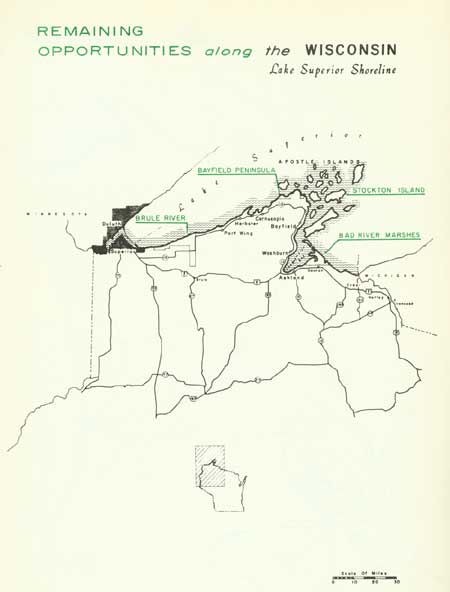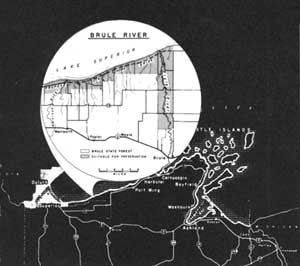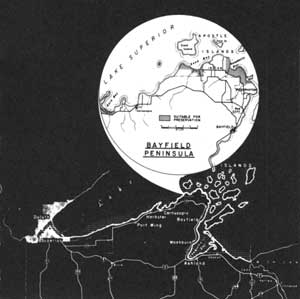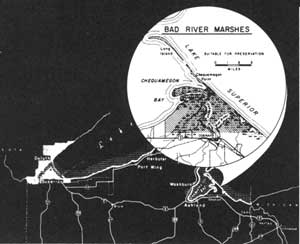|
NATIONAL PARK SERVICE
Great Lakes Shoreline Recreation Area Survey |

|
REMAINING OPPORTUNITIES IN WISCONSIN

|
| Remaining Opportunities in Wisconsin — Lake Superior Shoreline (Vicinity Map) (click on image for an enlargement in a new window) |
SUMMARY
Wisconsin has shore frontage on both Lake Superior and Lake Michigan. On Lake Superior, counting the 175 miles of shoreline of the Apostle Islands, Wisconsin has a total of 325 miles of shore frontage. As a geographical unit, it is best considered in four segments, each sufficiently distinct to pose problems to the recreation planner.
From Superior to Port Wing and from the Michigan state line westward for several miles is a region of shore bluffs. The bluffs vary from 20 to 60 feet in height and are fronted by very narrow beaches, 10 to 40 feet wide, composed of sand, gravel, cobble and rock, and variously littered with driftwood. The soft sand and clays of these old lakebed deposits are easily eroded, and the land back from the lake is cut by ravines and stream beds. Obviously, little recreation value can be attached to beach use, but a number of the streams entering the lake have trout runs of consequence. The Brule River is such an example, and for this and other important reasons it is included as a study area representative of this section.
East of Port Wing is the Bayfield Peninsula, the most scenic portion of the mainland shoreline. Steep sloped, rocky headlands are interspersed with sandy bays. The bays, sometimes backed by small marshlands and nestled between the higher prominences, are the focus of recreation possibilities on this shore segment.
The Apostle Islands are really a partially inundated extension of the Bayfield Peninsula, but their insular position introduces considerations not like the mainland. Not only are the islands valuable for the overt forms of recreations: boating, beach use, camping, hiking, etc., but they can neatly preserve in a small package a characteristic portion of the natural landscape and its biology.
The fourth shore segment includes the Kakagon and Bad River Marshes. Their value for migratory waterfowl is great, and efforts should be made to preserve in public ownership this fine marsh area for the use for which it is best suited. Studies by appropriate state and federal agencies should be undertaken to determine a method of management that would best serve all concerned.
At present, the shoreline is either largely forested with second growth timber or given over to farming. Some cottage development occurs, mainly on the Bayfield Peninsula. Large iron-ore docks occur at both Ashland and Superior. The Red Cliff and Bad River Indian Reservations occupy approximately 48 miles of shoreline.
The Wisconsin state park system administers 31 areas, none of which occur on Lake Superior. The opportunity to acquire lands for park use would appear fairly good at present. In a few years time the picture could change considerably.
| WISCONSIN Lake Superior Shoreline |
BRULE RIVER

LOCATION One of Wisconsin's principal tributaries to Lake Superior is the Brule River. Flowing northward toward the largest of the Great Lakes, this stream's mouth is approximately 20 miles east of Superior, Wisconsin. State Highway 13 and connecting county routes provide access to the shoreline of Lake Superior between the Brule and the Amicon Rivers. Further access along this shore line will be provided by a proposed South Shore Drive through the study area. A shoreline of 13.5 miles lies between the Brule and Amicon Rivers; inland, a strip 1 to 2 miles wide along Lake Superior and a 2-mile corridor along the Brule River amounts to 25,000 acres.
DESCRIPTION The Lake Superior shoreline between the Amicon and the Brule Rivers is characterized by low bluffs with narrow beaches. Wider shores are confined to the mouths of the two main rivers (the largest belonging to the Brule River). Here, the beaches are composed of fine sands and average approximately 25 feet in width.
The Brule River, one of the famous rainbow and brown trout streams of the United States, extends inland along a winding course for nearly 66 miles. Its fame as a trout stream is rivaled only by its scenic beauty and its challenge as a "white-water" canoe route. (The rapids of the Brule are a fitting test for the best canoeist.) Covering the banks of the stream and lakeshore north of the settlement of Brule are forests composed primarily of cutover aspen and birch with a light mixture of conifers. Today, the forests along the stream serve as important factors in the protection of the Brule River and its watershed, since the heavy clay soil and rough topography are susceptible to erosion and watershed damage.
Historically, the Brule River was a portion of the route the Indians and voyageurs followed to the portage between Lake Superior and the Mississippi River waterways. Their portage was at the Brule Bog between the Brule and the St. Croix Rivers.
PRESENT USE The southern half of the river is now within the Brule River State Forest, but the northern half has been crowded by farming and some cottage development. The appeal of the stream to canoeist and fisherman has a strong attraction to the sportsman.
ANALYSIS To achieve the objectives of watershed and forest management as well as to protect recreational opportunities, consideration should be given to extension of the State Forest to and along Lake Superior.

|
| Brule River |
| WISCONSIN Lake Superior Shoreline |
BAYFIELD PENINSULA

LOCATION The blunt tip of the Bayfield Peninsula projects conspicuously into Lake Superior as one of Wisconsin's principal shore prominences. With one exception, the bays associated with this shoreline proposal lie on the peninsula's northern tip. The nearest communities are Bayfield and Cornucopia. Both settlements are served by State Route 13 which together with county roads provide access into this region. Three separate Bayfield units involve nearly 12 miles of shoreline and an inland area of almost 4,800 acres.
DESCRIPTION Red sandstone and clay bluffs are the typical shore features of the Bayfield Peninsula. Interspersed along these bluffs are a number of bays that account for the uneven shore outline. Nearly all the bays that have been cut back into the shores of the peninsula are characterized by sand beaches. These beaches of fine sand vary in width from a narrow strand up to 40 or 50 feet. Some of the finest beaches are located at Frog, Sand and Bark Bays.
Frequently, behind the beaches, marshes are associated with streams draining the inland region and feeding Lake Superior. The three previously named bays are examples of such beach and marsh environment. The trees and shrubs that line these beaches have trapped some of the loose sand, building up the barrier strand between the marsh and bay. Bordering these wetlands will be found stands of pine, spruce and fir; elsewhere, the conifers occur as scattered groups in a predominantly deciduous forest composed primarily of birch and aspen.
A rolling countryside of rounded ridges and shallow valleys characterizes the Bayfield Peninsula. Only the shore points demonstrate a boldness of outline. Battered by Lake Superior's wave action, some of the points have been carved to form arches and caves in the sandstone rock.
PRESENT USE The northernmost part of the Bayfield Peninsula is included in the Red Cliff Indian Reservation; however, private and county lands form a checkerboard pattern with Indian lands. Three of the four bays in the Bayfield proposal are within the reservation, but involve only a small acreage of restricted Indian allotments. Very few developments exist, leaving the region largely in a natural, unspoiled condition.
ANALYSIS The beaches and surrounding terrain of the Bayfield Peninsula offer excellent sites for several small park units. Public acquisition of this portion of Wisconsin's Lake Superior shore would save a scenic region possessing outstanding potential vital to future recreation needs.

|
| Bayfield Peninsula |
| WISCONSIN Lake Superior Shoreline |
STOCKTON ISLAND

LOCATION The Apostle Islands lie off the Bayfield Peninsula as one of Lake Superior's principal shoreline features. Occupying an area of nearly 600 square miles, this archipelago has a land area of less than 80 square miles. State Route 13 and U.S. Route 2 provide access to mainland points such as Ashland, Bayfield and Washburn, Wisconsin, where boat transportation to the islands is available. Stockton Island, lying near the middle of the group, is the only unit of the Apostles included in this proposal. Its 10,000 acres inscribe a shoreline of nearly 21 miles.
DESCRIPTION At present, the Apostle Islands include more than 20 islands ranging in size from 175 to 15,000 acres. Formerly they were part of the Bayfield Peninsula but became separated during the ice age. Today the islands are characterized by low, nearly level outlines of glacial drift lying over their red sandstone foundations. Occasionally, these sandstones are exposed along the shoreline where they form sheer walls, caves or arches; elsewhere, eroding clay banks are typical of the island shoreline.
Stockton, the second largest of the islands, has been selected as the unit incorporating most of the Apostle Islands' features. On the island's Presque Isle Point may be found many typical vegetative types. This includes the bog habitats with sundew, pitcher plant and other bog species. In drier locations, red pine copses along with stands of northern hard woods may be found. Second growth stands are typical of nearly the entire island group.
Sand beaches occur along portions of Stockton's south shore, particularly the east side of Presque Isle Point. These sand beaches average approximately 50 feet in width, terminating in a low barrier dune. Lake Superior's chilly waters discourage all but the hardiest from swimming; however, the beaches have a scenic appeal worthy of recognition.
PRESENT USE Because of its large deer herd, a situation currently true of nearly all the Apostles, hunting is one of the principal autumn activities. The decline of commercial fishing has resulted in the abandonment of several fishing operations on the island, leaving Stockton virtually uninhabited.
ANALYSIS By virtue of its island setting, Stockton offers a unique experience in many outdoor activities, such as camping and boating, not found on mainland areas. By the inclusion of representative features typical of the Apostle Islands, Stockton possesses recreation potential that should be recognized by public acquisition.

|
| Stockton Island |
| WISCONSIN Lake Superior Shoreline |
BAD RIVER MARSHES

LOCATION Behind the protection of Chequamegon Point lies the delta-like region of the Bad River and Kakagon River marshes. These wetlands are situated approximately 6 miles north. east of Ashland, Wisconsin and are accessible via U.S. Highway 2 and thence by boat into the interior of the marshes. This area, plus Long Island, involves approximately 11,000 acres north of U.S. Highway 12 and a shoreline of 25 miles.
DESCRIPTION The Bad River region in corporates two shoreline features rare not only to Wisconsin but Lake Superior as well. Of primary importance are the interior lands whose marshes have some of the greatest wildlife potential, particularly in terms of waterfowl, that remain unprotected on the Great Lakes. The second unusual feature is the sand beach fronting on Lake Superior, including Chequamegon Point's detached extension--Long Island.
The marsh flats are grown up mainly in wild rice but many other aquatic plants exist, including arrowhead, cattail and water lily. Tamarack bogs and alder thickets also occur, along with scattered sugar maple, basswood, ash and conifers on higher lands. In terms of wildlife, these marshes give evidence of supporting a varied fauna within a favorable northern habitat. Deer occur throughout the area's network of upland hummocks, while muskrat and, possibly, beaver inhabit the marshes. Walleye and great northern pike are popular game fishes of the water courses. Probably the greatest value the area has is to meet waterfowl needs for food, shelter and resting places during migration and breeding seasons.
Along the Lake Superior shore, sand beaches form an effective barrier between the marshes and the lake. These beaches, averaging 50 feet in width, are bolstered by a low barrier dune that has been stabilized by beach grasses.
PRESENT USE The marshlands lie within the boundaries of the Bad River Indian Reservation; however, the pattern of ownership is a checkerboard of Federal, State County, Indian and private lands. Conflicting property claims have arisen, leaving a clouded picture of land ownership. Hunting and fishing camps, some on floats, have been located in the area while the marshlands are also the scene of annual wild rice harvests in the autumn by Indians from the Bad River Reservation.
ANALYSIS Because of the marshes' conservation values, this region should receive further study to determine its national significance in order to formulate a plan for preservation and management of the wildlife and recreation values for future public use.

|
| Bad River Marshes |
| <<< Previous | <<< Contents>>> | Next >>> |
rec_area_survey/gl/wi1.htm
Last Updated: 27-Jun-2007